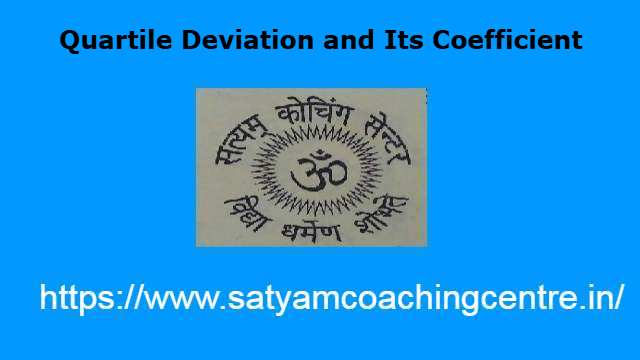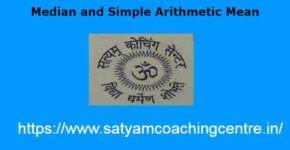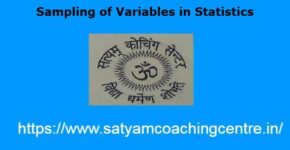Quartile Deviation and Its Coefficient
1.चतुर्थक विचलन और इसका गुणांक (Quartile Deviation and Its Coefficient),विस्तार और विस्तार गुणांक (Range and Cefficient of Range):
चतुर्थक विचलन और इसका गुणांक (Quartile Deviation and Its Coefficient) के इस आर्टिकल में चतुर्थक विचलन,चतुर्थक विचलन का गुणांक,विस्तार,विस्तार गुणांक आदि के बारे में अध्ययन करके समझने का प्रयास करेंगे।
आपको यह जानकारी रोचक व ज्ञानवर्धक लगे तो अपने मित्रों के साथ इस गणित के आर्टिकल को शेयर करें।यदि आप इस वेबसाइट पर पहली बार आए हैं तो वेबसाइट को फॉलो करें और ईमेल सब्सक्रिप्शन को भी फॉलो करें।जिससे नए आर्टिकल का नोटिफिकेशन आपको मिल सके।यदि आर्टिकल पसन्द आए तो अपने मित्रों के साथ शेयर और लाईक करें जिससे वे भी लाभ उठाए।आपकी कोई समस्या हो या कोई सुझाव देना चाहते हैं तो कमेंट करके बताएं।इस आर्टिकल को पूरा पढ़ें।
Also Read This Article:- Average and Geometric Mean
2.चतुर्थक विचलन और इसका गुणांक पर आधारित उदाहरण (Examples Based on Quartile Deviation and Its Coefficient):
Example:1.अपकिरण और विषमता के अन्तर स्पष्ट कीजिए।निम्नांकित बंटनों की प्रकृति की समीक्षा कीजिए:
(Point out the difference between dispersion and skewness.Comment on the nature of the following distribution):
\begin{array}{|c|c|ccccc|} \hline \text { बंटन } & \text{I} & 14 & 14 & 14 & 14 & 14 \\ \text { बंटन } & \text{II} & 11 & 12 & 14 & 16 & 17 \\ \text { बंटन } & \text{III} & 1 & 3 & 6 & 18 & 42 \\ \hline \end{array}
Solution:अपकिरण:अपकिरण के अन्तर्गत किसी समंक श्रेणी के विभिन्न पद-मूल्यों का बिखराव या बंटन की बनावट का अध्ययन किया जाता है।विभिन्न मापों तथा गुणांकों की सहायता से यह ज्ञात हो जाता है कि श्रेणी के मूल्यों का आपस में या किसी माध्य से कितना विचलन है।
विषमता:विषमता के माप व गुणांक हमें यह बताते हैं कि श्रेणी के माध्य से दोनों ओर के भागों का विचरण बराबर है या किसी एक भाग का अधिक है।दूसरे शब्दों में,विषमता से यह ज्ञात होता है कि आवृत्ति-वक्र सममित है या असममित और यदि असममित है तो किस ओर है और कितनी मात्रा में है।अतः अपकिरण से पूरे समूह की बनावट (compotition) का अध्ययन होता है जबकि विषमता से उसके स्वरूप (shape) का पता चलता है।
Calculation Table of Mean and Deviation
\begin{array}{|l|cl|cl|cc|} \hline & \text {बंटन} & & \text {बंटन} & & \text {बंटन} \\ & \text{I} & & \text{II} & & \text{III} \\ \hline S\text{. No.} & x & Deviation & y & Deviation & z & Deviation \\ \hline 1 & 14 & 0 & 11 &-3 & 1 & -13 \\ 2 & 14 & 0 & 12 & -2 & 3 & -11 \\ 3 & 14 & 0 & 14 & 0 & 6 & -8 \\ 4 & 14 & 0 & 16 & +2 & 18 &+4 \\ 5 & 14 & 0 & 17 & +3 & 42 & +28 \\ \hline \text{Total} & 70 & & 70 & & 70 \\ \hline \text{Mean} & 14 & & 14 & & 14 \\ \hline \end{array}
उक्त सारणी में तीनों बंटनों के माध्य एक समान है परन्तु उनकी बनावट में बहुत अन्तर है।प्रथम बंटन में प्रत्येक मूल्य 14 है अतः इसमें माध्य पूर्ण रूप से समस्त समूह का उचित प्रतिनिधित्व कर रहा है।द्वितीय बंटन में भी माध्य 14 है परन्तु बनावट पहले से भिन्न है।इसमें न्यूनतम 11 तथा अधिकतम 17 का अन्तर 6 है तथा इन मूल्यों के विचलन क्रमशः -3 तथा +3 है।इस श्रेणी का माध्य सभी मूल्यों का यथोचित प्रतिनिधि नहीं कहा जा सकता है।फिर भी यह कुछ मात्रा में समूह का प्रतिनिधित्व करता है।तृतीय बंटन में भी माध्य तो 14 ही है परन्तु पद-मूल्यों में विचलन बहुत अधिक है।इसमें न्यूनतम व अधिकतम मूल्य क्रमशः 1 और 42 है,उनका विस्तार 42-1=41 है और उनके विचलन क्रमशः -13 एवं +28 है।इस बंटन में माध्य,केन्द्रीय प्रवृत्ति का उचित प्रतिनिधित्व नहीं करता।
समंकमालाओं में उपर्युक्त अन्तर के कारण केवल माध्य के आधार पर सही निष्कर्ष नहीं निकाले जा सकते।उनकी बनावट और स्वरूप के बारे में भी सूचना प्राप्त करना अत्यावश्यक है।
Example:2(i).विद्यार्थियों के दो समूहों की लम्बाई (से०मी०) के आँकड़े निम्नांकित हैं:
\begin{array}{|lllllll|l|} \hline \text{समूह (Group) I } & \text{ समूह (Group) II} \\ 167 & 169 \\ 162 & 172 \\ 155 & 168 \\ 180 & 165 \\ 182 & 177 \\ 175 & 180 \\ 185 & 195 \\ 158 & 167 \\ \hline \end{array}
दोनों समूहों की लम्बाई के विस्तार (range) की तुलना कीजिए।
Solution:विस्तार गुणांक (C.R.)=\frac{L-S}{L+S}
C.R. Group I=\frac{185-155}{185+155}=\frac{30}{340} \approx 0.088
विस्तार गुणांक (C.R.)=\frac{195-165}{195+165}=\frac{30}{360}
C.R. Group II \approx 0.083
Example:2(ii).एक श्रेणी में विस्तार का सापेक्ष माप 29 और अधिकतम मूल्य 64.5 है | न्यूनतम मूल्य बताइए|
Solution:न्यूनतम मूल्य=64.5-29=35.5
Example:3.किसी परीक्षा में 25 छात्रों को निम्न अंक प्राप्त हुएः
\begin{array}{|cccccccc|} \hline \text{अंक} & \text{ छात्रों की संख्या } \\ 5-9 & 1 \\ 10-14 & 3 \\ 15-19 & 8 \\ 20-24 & 5 \\ 25-29 & 4 \\ 30-34 & 2 \\ 35-39 & 2 \\ \hline \end{array}
(i)विस्तार गुणांक (cefficient of range);
(ii)माध्य के 50% अंकों का विस्तार;
(iii)केन्द्रीय 80% का विस्तार ज्ञात कीजिए।
Solution:(i).विस्तार गुणांक (C.R.)=\frac{L-S}{L+S} \\ =\frac{39.5-4.5}{39.5+4.5} \\ =\frac{35}{44} \\ \approx 0.795
(ii)Calculation Table of Quartiles and Percentiles
\begin{array}{|ccc|} \hline \text {Marks} & \text {(f)} & \text {cf} \\ \hline 4.5-9.5 & 1 & 1 \\ 9.5-14.5 & 3 & 4 \\ 14.5-19.5 & 8 & 12 \\ 19.5-24.5 & 5 & 17 \\ 24.5-29.5 & 4 & 21 \\ 29.5-34.5 & 2 & 23 \\ 34.5-39.5 & 2 & 25 \\ \hline \text { Total } & 25 & \\ \hline \end{array}
(i)q_1=\frac{N}{4} \\ = \frac{25}{4}=6.25
\therefore 14.5-19.5 is the Q_1 Class
l=14.5,f=8,c=4
Q_1=l+\frac{i}{5}\left(q_1-c\right) \\ =14.5+\frac{5}{8}(6.25-4) \\ =14.5+\frac{5}{8} \times 2.25 \\ =14.5+\frac{11.25}{8}=14.5+1.40625 \\ \Rightarrow Q_1 \approx 15.91 \\ q_3=\frac{3 N}{4}=\frac{3 \times 25}{4}=18.75
24.5-29.5 is the Q_3 Class
l=24.5,i=29.5-24.5=5,f=4,c=17
Q_3=l+\frac{i}{f}\left(q_2-c\right) \\ =24.5+\frac{5}{4}(18.75-17) \\ =24.5+\frac{5}{4} \times 1.75 \\ =24.5+\frac{8.75}{4}=24.5+2.1875 \\ \Rightarrow Q_3 \approx 26.69
माध्य के 50% अंकों का विस्तार=Q_3-Q_1
=26.69-15.91=10.78
(iii)p_{10}=\frac{10N}{100}=\frac{10 \times 25}{100}=2.5
\therefore 8.5-14.5 is P_{10} the Class
l=9.5,i=14.5-9.5=5,f=3,c=1
P_{10}=l+\frac{i}{f}\left(p_{10}-c\right) \\ =9.5+\frac{5}{3}(2.5-1) \\ =9.5+\frac{5}{3} \times 1.5 \\=9.5+2.5 \\ \Rightarrow P_{10}=12 \\ p_{90}=\frac{90 N}{100}=\frac{90 \times 25}{100}=22.5
29.5-34.5 is the P_{90} Class
l=29.5,i=34.5-29.5=5,f=2,c=21
P_{90}=l+\frac{i}{5}\left(p_{90}-c\right) \\ =29.5+\frac{5}{2}(22.5-21) \\ =29.5+\frac{5}{2} \times 1.5 \\ =29.5+3.75 \\ P_{90}=33.25
केन्द्रीय 80% अंकों का विस्तार=P_{90}-P_{10}
=33.25-12=21.25
Example:4.निम्नलिखित समंकों के चतुर्थक विचलन और उसका गुणांक मालूम कीजिए:
(From the following data,find the quartile deviation and its coefficient):
\begin{array}{|cc|} \hline \text{Month} & \text{Income} \\ 1 & 39 \\ 2 & 40 \\ 3 & 40\\ 4 & 41 \\ 5 & 41 \\ 6 & 42 \\ 7 & 42 \\ 8 & 43 \\ 9 & 43 \\ 10 & 44\\ 11 & 44 \\ 12 & 45 \\ \hline \end{array}
Solution: Q_1= value of \frac{N+1}{4} th item
=value of \frac{12+1}{4} th item
=3.25 th item
Q_1=value of 3+.25(value of 4th- 3rd item)
\Rightarrow Q_1=40+.25(41-40)=40.25
Q_3=value of \frac{3(N+1)}{4} th item
=value of \frac{3(12+1)}{4} th item
=value of 9.75
=Value of 9+.75(value of 10th-9th item)
=43+.75(44-43)
Q_3=43+.75 \times 1=43.75
Q.D.=\frac{Q_3-Q_1}{2}=\frac{43.75-40.25}{2} \\ \Rightarrow \text{Q.D.}=\frac{3.5}{2}=1.75
Coefficient of Q.D.=\frac{Q_3-Q_1}{Q_3+Q_1} \\ =\frac{43.75-40.25}{43.75+40.25} \\ =\frac{3.50}{84} \approx 0.0416
\Rightarrow C of Q.D. \approx 0.042
Example:5.निम्नलिखित अंकों से चतुर्थक विचलन तथा उसका गुणांक ज्ञात कीजिए:
(From the following figures find the quartile deviation and its coefficient):
\begin{array}{|cc|} \hline \text{Height} & \text{No. of} \\ \text{cms.} & \text{students} \\ 150 & 15 \\ 151 & 20 \\ 152 & 32 \\ 153 & 35 \\ 154 & 33 \\ 155 & 22\\ 156 & 20 \\ 157 & 12\\ 158 & 10 \\ \hline \end{array}
Solution:Calculation Table of Quartile
\begin{array}{|ccc|} \hline \text { Height } & \begin{array}{c} \text { No. of } \\ \text { student } \end{array} & \begin{array}{c} \text { cum. freq. } \\ \text {cf} \end{array} \\ \hline 150 & 15 & 15 \\ 151 & 20 & 35 \\ 152 & 32 & 67 \\ 153 & 35 & 102 \\ 154 & 33 & 135 \\ 155 & 22 & 157 \\ 156 & 20 & 177 \\ 157 & 12 & 189 \\ 158 & 10 & 199 \\ \hline \text { Total } & 199 & \\ \hline \end{array}
Q_1=size of \frac{N+1}{4} th item
=size of \frac{199+1}{4} th item
=size of 50th item
\Rightarrow Q_1=152
Q_3=size of \frac{3(N+1)}{4} th item
=size of \frac{3(199+1)}{4} th item
=size of \frac{3 \times 200}{4} th item
=size of 150th item
\Rightarrow Q_3=155
Q.D.=\frac{Q_3-Q_1}{2}=\frac{155-152}{2}=\frac{3}{2}=1.5
Coefficient of Q.D.=\frac{Q_3-Q_1}{Q_3+Q_1} \\ =\frac{155-152}{155+152} \\ =\frac{3}{307}
\Rightarrow C of Q.D. \approx 0.0098
Example:6.निम्नलिखित सारणी से चतुर्थक विचलन ज्ञात कीजिए:
(Find the quartile deviation from the following table):
\begin{array}{|cc|} \hline \text{Size} & \text{Frequency} \\ \hline 4-8 & 6 \\ 8-12 & 10 \\ 12-16 & 18 \\ 16-20 & 30 \\ 20-24 & 15 \\ 24-28 & 12 \\ 28-32 & 10 \\ 32-36 & 6 \\ 36-40 & 2 \\ \hline\end{array}
Solution:Calculation Table of Quartile
\begin{array}{|ccc|} \hline \text{Size} & \text{Frequency} & \text{cum. freq.}\\ & (f) & (cf)\\ \hline 4-8 & 6 & 6 \\ 8-12 & 10 & 16 \\ 12-16 & 18 & 34 \\ 16-20 & 30 & 64 \\ 20-24 & 15 & 79 \\ 24-28 & 12 & 91 \\ 28-32 & 10 & 101 \\ 32-36 & 6 & 107 \\ 36-40 & 2 & 109 \\ \hline \text { Total } & 109 & \\ \hline \end{array} \\ q_1=\frac{N}{4}=\frac{109}{4}=27.25
\therefore 12-16 is Q_1 the Class
l=12,i=16-12=4,f=18,c=16
Q_1=l+\frac{i}{f}\left(q_1-c\right) \\ =12+\frac{4}{18}(27.25-16) \\ =12+\frac{2}{9} \times 11.25 \\=12+\frac{22.5}{9} \\ =12+2.5 \\ \Rightarrow Q_1=14.5 \\ q_3=\frac{3 N}{4}=\frac{3 \times 109}{4}=81.75
\therefore 24-28 is the Q_3 Class
l=24,i=28-24=4,f=12,c=79
Q_3=l+\frac{i}{f}\left(q_3-c\right) \\ =24+\frac{4}{12}(81.75-79) \\ =24+\frac{1}{3} \times 2.75 \\ \approx 24+0.92 \\ \Rightarrow Q_3 \approx 24.93 \\ \text{Q.D.}=\frac{Q_3-Q_1}{2}=\frac{24.93-14.5}{2}
\Rightarrow Q.D. \approx 5.22
Example:7.एक लोक सेवा परीक्षा में प्राप्तांकों के निम्न बंटन से चतुर्थक विचलन गुणांक ज्ञात कीजिए।
(Calculate the coefficient of quartile deviation from the following distribution of marks obtained in a public service examination):
\begin{array}{|cc|} \hline \text{Marks} & \text{No. of students} \\ \hline 0-10 & 3\\ 10-20 & 9 \\ 20-30 & 12 \\ 30-40 & 20 \\ 40-50 & 8 \\ 50-60 & 6\\ 60-70 & 6 \\ 70-80 & 5 \\ \hline \end{array}
Solution:Calculation Table of Quartile
\begin{array}{|ccc|} \hline \text {Marks} & \text{No. of} & \text{cum. Freq.} \\ & \text {students(f)} & (cf) \\ \hline 0-10 & 3 & 3 \\ 10-20 & 9 & 12 \\ 20-30 & 12 & 24 \\ 30-40 & 20 & 44 \\ 40-50 & 8 & 52 \\ 50-60 & 6 & 58 \\ 60-70 & 6 & 64 \\ 70-80 & 5 & 69 \\ \hline \text { Total } & 69 & \\ \hline \end{array} \\ q_1=\frac{N}{4}=\frac{69}{4}=17.25
\therefore 20-30 is the Q_1 Class
l=20,i=30-20=10,f=12,c=12
Q_1=l+\frac{i}{f}\left(q_1-c\right) \\ =20+\frac{10}{12}(17.25-12) \\ =20+\frac{5}{6} \times 5.25 \\ =20+\frac{26.25}{6} \\ =20+4.375 \\ \Rightarrow Q_1=24.375 \\ q_3=\frac{3N}{4} =\frac{3 \times 69}{4} =\frac{207}{4}=51.75
\therefore 40-50 is the Q_3 Class
l=40,i=50-40=10,f=8,c=44
Q_3=l+\frac{i}{f}\left(q_3-c\right) \\ =40+\frac{10}{8}(51.75-44) \\ =40+\frac{5}{4}(7.75) \\ =40+\frac{38.75}{4} \\ =40+9.6875 \\ \Rightarrow Q_3=49.6875
Coefficient of Q.D.=\frac{Q_3-Q_1}{Q_3+Q_1} \\ =\frac{49.6875-24.375}{49.6875+24.375} \\ =\frac{25.3125}{74.0625}
\Rightarrow C. of Q.D. \approx 0.342
Example:8.किसी कक्षा में विद्यार्थियों की ऊँचाई के आँकड़े निम्न सारणी में दिए गए हैं।चतुर्थक विचलन ज्ञात कीजिए:
(The following table gives the height of students.Find the quartile deviation):
\begin{array}{|ll|} \hline \text{Height} & \text{No .of} \\ \text{inches} & \text{students} \\ \hline 50-55 & 2 \\ 55-56 & 7 \\ 56-59 & 24 \\ 59-62 & 27 \\ 62-65 & 13 \\ 65-68 & 3 \\ \hline \end{array}
Solution:Calculation Table of Quartile
\begin{array}{|ccc|} \hline \text{Height} & \text{No. of students} & \text{cum. Freq.}\\ & (f) & (cf) \\ \hline 50-55 & 2 & 2 \\ 55-56 & 7 & 9 \\ 56-59 & 24 & 33 \\ 59-62 & 27 & 60 \\ 62-65 & 13 & 73 \\ 65-68 & 3 & 76 \\ \hline \text{Total} & 76 & \\ \hline \end{array} \\ q_1=\frac{N}{4}=\frac{76}{4}=19
\therefore 56-59 is the Q_1 Class
l=56,i=59-56=3,f=24,c=9
Q_1=l+\frac{i}{f}\left(q_1-c\right) \\ =56+\frac{3}{24}(19-9) \\ =56+\frac{1}{8} \times 10=56+1.25 \\ \Rightarrow Q_1=57.25 \\ q_3=\frac{3 N}{4}=\frac{3 \times 76}{4}=57
\therefore 59-62 is the Q_3-Class
l=59,i=62-59=3,f=27,c=33
Q_3=l+\frac{i}{f}\left(q_3-c\right) \\ =59+\frac{3}{27}(57-33) \\ =59+\frac{1}{9} \times 24 \\ \approx 59+2.64 \\ \Rightarrow Q_3 \approx 61.67
चतुर्थक विचलन (Q.D.)=\frac{Q_3-Q_1}{2}=\frac{61.67-57.25}{2} \\ \Rightarrow Q.D.=\frac{Q_3-Q_1}{2}=\frac{61.67-57.25}{2}\\ \Rightarrow Q.D. \approx 2.21
Example:9.निम्न सारणी से अर्द्ध-अन्तर चतुर्थक विस्तार और चतुर्थक विचलन गुणांक परिकलित कीजिए:
(Calculate the semi-inter quartile range and the coefficient of quartile deviation from the following table):
\begin{array}{|cc|} \hline \text{class} & \text{Frequency} \\ \hline 33-36 & 2 \\ 30-33 & 7 \\ 28-30 & 7 \\ 25-28 & 8 \\ 24-25 & 5 \\ 20-24 & 17 \\ 18-20 & 13 \\ 14-18 & 15 \\ 12-14 & 10 \\ 9-12 & 8 \\ 6-9 & 4 \\ 0-6 & 4 \\ \hline\end{array}
Solution:Calculation Table of Quartile
\begin{array}{|ccc|} \hline \text{class} & \text{Freq.} & \text{Cum. freq.} \\ & (f) & (cf)\\ \hline 0-6 & 4 & 4 \\ 6-12 & 12 & 16 \\ 12-18 & 25 & 41 \\ 18-24 & 30 & 71 \\ 24-30 & 20 & 91 \\ 30-36 & 9 & 100 \\ \hline \text { Total } & 100 & \\ \hline \end{array} \\ q_1=\frac{N}{4}=\frac{100}{4}=25
\therefore 12-18 is the Q_1-Class
l=12,i=18-12=6,f=25,c=16
Q_1=l+\frac{i}{5}\left(q_1-c\right) \\ =12+\frac{6}{25}(25-16) \\ =12+\frac{6}{25} \times 9=12+2.16 \\ \Rightarrow Q_1=14.16 \\ q_3=\frac{3 N}{4}=\frac{3 \times 100}{4}=75
\therefore 24-30 is the Q_3-Class
l=24,i=30-24=6,f=20,c=71
q_3=i+\frac{i}{f}\left(q_3-c\right) \\ =24+\frac{6}{20}(75-71) \\ \Rightarrow Q_3=24+\frac{3}{10} \times 4=24+1.2=25.2
चतुर्थक विचलन (Q.D.)=\frac{Q_3-Q_1}{2}=\frac{25.2-14.16}{2} \\ \Rightarrow \text{Q.D.}=5.52
Coefficient of Q.D.=\frac{Q_3-Q_1}{Q_3+Q_1}=\frac{25.2-14.16}{25.2+14.16} \\ =\frac{11.04}{39.36}
c of Q.D. \approx 0.28
उपर्युक्त उदाहरणों के द्वारा चतुर्थक विचलन और इसका गुणांक (Quartile Deviation and Its Coefficient),विस्तार और विस्तार गुणांक (Range and Cefficient of Range) को समझ सकते हैं।
3.चतुर्थक विचलन और इसका गुणांक की समस्याएँ (Quartile Deviation and Its Coefficient Problems):
(1.)निम्न आँकड़ों से अपकिरण का चतुर्थक माप एवं उसका गुणक ज्ञात कीजिए।
(Calculate Quartile measure of dispersion and its coefficient from the following data):
\begin{array}{|clllllll|} \hline \text{Size of item} & 4 & 6 & 8 & 10 & 12 & 14 & 16 \\ \text{Frequency} & 2 & 4 & 5 & 3 & 2 & 1 & 4 \\ \hline \end{array}
(2.)निम्नांकित समंकों से अर्द्ध-अन्तर चतुर्थक विस्तार एवं उसका गुणक ज्ञात कीजिए:
(Compute semi-Inter Quartile Range and its coefficient):
\begin{array}{|lllllllllll|} \hline \text{Central size} & 1 & 2 & 3 & 4 & 5 & 6 & 7 & 8 & 9 & 10 \\ \text{Frequency} & 2 & 9 & 11 & 14 & 20 & 24 & 20 & 16 & 5 & 2 \\ \hline \end{array}
उत्तर (Answers):(1.)Q.D.=4, C of Q.D.=0.40
(2.)Q.D.=1.495 units,C of Q.D.=0.27
उपर्युक्त सवालों को हल करने पर चतुर्थक विचलन और इसका गुणांक (Quartile Deviation and Its Coefficient),विस्तार और विस्तार गुणांक (Range and Cefficient of Range) को ठीक से समझ सकते हैं।
Also Read This Article:- Numerical Illustrations of Mean and HM
4.चतुर्थक विचलन और इसका गुणांक (Frequently Asked Questions Related to Quartile Deviation and Its Coefficient),विस्तार और विस्तार गुणांक (Range and Cefficient of Range) से सम्बन्धित अक्सर पूछे जाने वाले प्रश्न:
प्रश्न:1.अर्द्ध-अन्तर चतुर्थक विस्तार को स्पष्ट करो। (Clarify the Semi-Inter Quartile Range):
उत्तर:तृतीय चतुर्थक तथा प्रथम चतुर्थक के अन्तर के आधे को चतुर्थक विचलन (Quartile Deviation) या अर्द्ध-अन्तर चतुर्थक विस्तार (Semi-Inter Quartile Range) कहते हैं।
Q.D.=\frac{Q_3-Q_1}{2}
प्रश्न:2.चतुर्थकों और चतुर्थक विचलन गुणांक का सूत्र लिखो। (Write the Formulae for Quartiles and Coefficient of Quartile Deviation):
उत्तर: Q_1=l+\frac{i}{f}\left(q_1-c\right), Q_2=l+\frac{i}{f}\left(q_3-c\right)
c. of Q.D.=\frac{Q_3-Q_1}{Q_3+Q_1}
प्रश्न:3.चतुर्थक-विचलन गुणांक पर टिप्पणी लिखो। (Write Short Note on Coefficient of Quartile Deviation):
उत्तर:चतुर्थक-विचलन अपकिरण का निरपेक्ष माप है।विभिन्न श्रेणियों के चतुर्थक विचलन की तुलना करने के लिए इसका सापेक्ष माप निकाला जाता है।यह सापेक्ष माप,चतुर्थक विचलन गुणांक कहलाता है।
उपर्युक्त प्रश्नों के उत्तर द्वारा चतुर्थक विचलन और इसका गुणांक (Quartile Deviation and Its Coefficient),विस्तार और विस्तार गुणांक (Range and Cefficient of Range) के बारे में और अधिक जानकारी प्राप्त कर सकते हैं।
| No. | Social Media | Url |
|---|---|---|
| 1. | click here | |
| 2. | you tube | click here |
| 3. | click here | |
| 4. | click here | |
| 5. | Facebook Page | click here |
| 6. | click here | |
| 7. | click here |
Quartile Deviation and Its Coefficient
चतुर्थक विचलन और इसका गुणांक
(Quartile Deviation and Its Coefficient)
Quartile Deviation and Its Coefficient
चतुर्थक विचलन और इसका गुणांक (Quartile Deviation and Its Coefficient) के इस
आर्टिकल में चतुर्थक विचलन,चतुर्थक विचलन का गुणांक,विस्तार,विस्तार गुणांक आदि के
बारे में अध्ययन करके समझने का प्रयास करेंगे।
Related Posts
About Author
Satyam
About my self I am owner of Mathematics Satyam website.I am satya narain kumawat from manoharpur district-jaipur (Rajasthan) India pin code-303104.My qualification -B.SC. B.ed. I have read about m.sc. books,psychology,philosophy,spiritual, vedic,religious,yoga,health and different many knowledgeable books.I have about 15 years teaching experience upto M.sc. ,M.com.,English and science.








